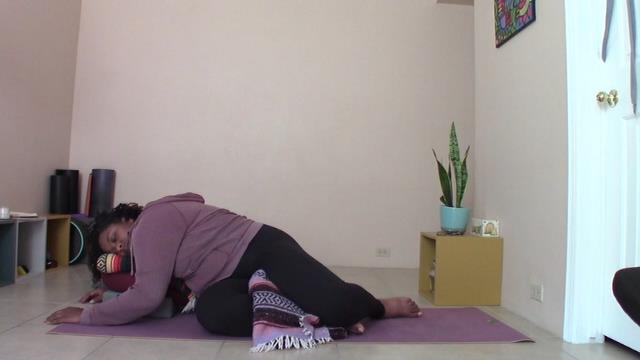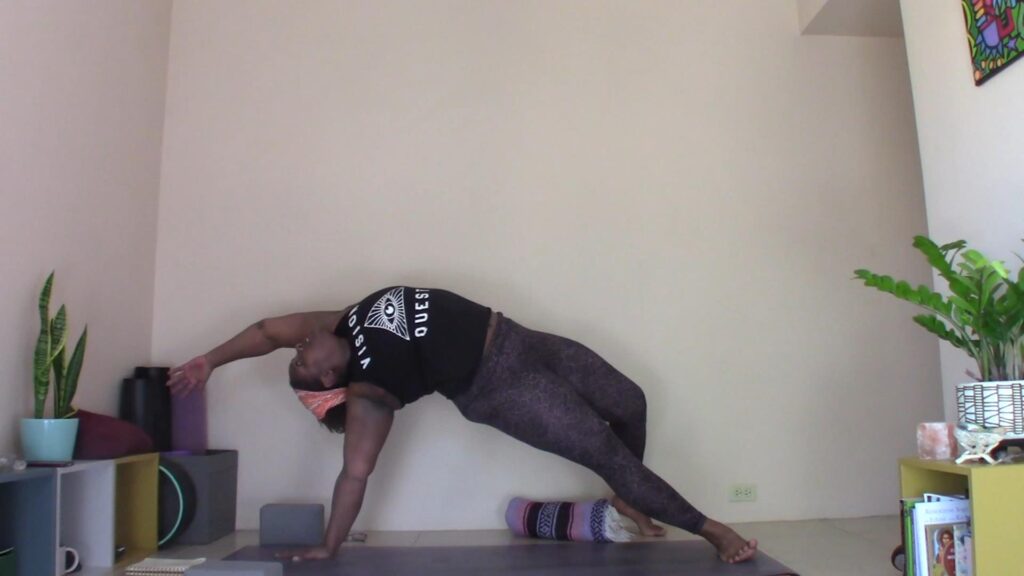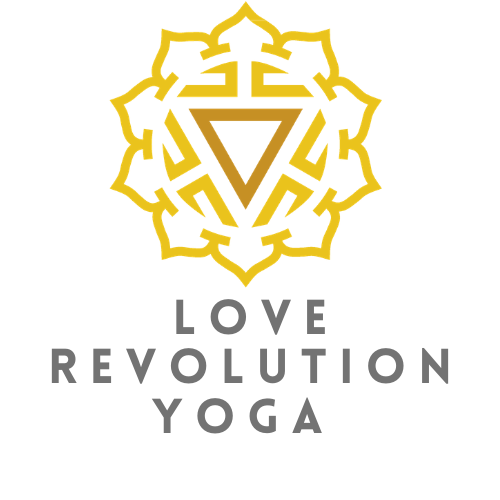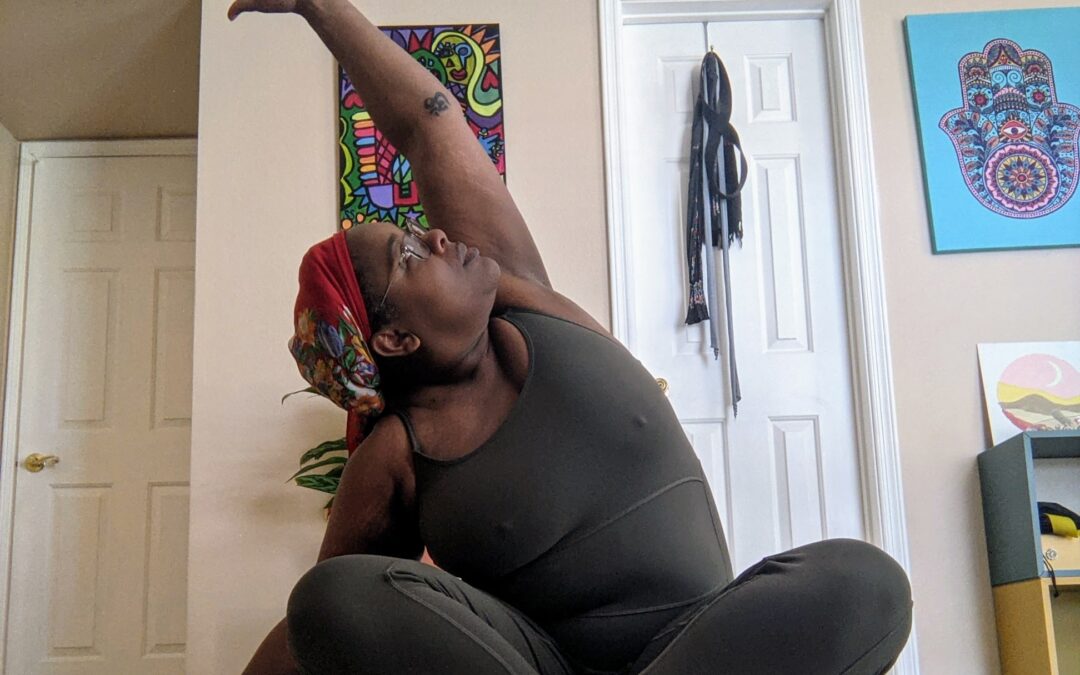My yoga practice started at home.
I was 18 with a new baby, looking for a job planning to attend community college as soon as I could enroll. I just didn’t want to be another teenage-mother-who-never-lives-up-to-her-potential statistic.
I was stressed AF and I know I didn’t understand how to regulate my nervous system. I was just bottling all the stress and waiting for the day I was back in the pool, experiencing the Zen of swimming.
When my grandmother handed me Richard Hittleman’s Yoga 28-Day Exercise Plan, I just saw something that would get me moving again.
The first few days were like one asana, a short meditation, and a little philosophy. I learned to breathe (outside of the water), self-soothe, and move my body without the need for external motivation or guidance.
For a long time, the practice was just physical. Even when I started going to studio yoga classes 10 years later. I was there to move my body and it took me a long time to notice the mental, emotional, and spiritual benefits of the practice.
And while I had emotional releases on the mat, the biggest transformation was manifesting in the form of improved mobility and flexibility, and handling stress in a less reactive manner.
Returning to My Home Yoga Practice Foundation

After college, I settled into a largely sedentary lifestyle. As a competitive athlete from childhood through college, my movement practice had been structured and prescribed. I never really learned to be self-guided in that practice. So when I started practicing at the studio, viewing yoga as a form of fitness felt really accessible.
But studio classes and memberships are expensive and when I couldn’t afford to practice in studio, I started practicing yoga at home again. My space was small but I would move the coffee table and set up my mat in my living room and move through some sun salutations. And sometimes I even found classes on YouTube to support my home practice.
I found it so empowering that I could just move and breathe and be with myself in the yoga practice without the need for external guidance or validation. And I learned that I can take my practice with me anywhere. In a way, my home practice became a sort of self validation all its own.
My home practice continued to serve me when I became a yoga teacher, when I was teaching 8-10 classes a week and my schedule didn’t facilitate taking studio classes as often as I liked — and my body couldn’t handle another hour in a hot room.
It was my home yoga practice that enabled me to stay grounded, centered, and mobile, so that I could go into those hot rooms and guide people through their practice with depth and authenticity.
And when pandemic shut downs were implemented in 2020, my home practice became a kind of refuge and one of the most important aspects of my self-care routine. In fact, I have gotten into the habit of starting most mornings with some kind of movement and meditation.
Perhaps more important than learning to guide myself through a movement practice was how yoga has helped me develop a loving and compassionate relationship with myself. My asana practice became less about conditioning for a specific pose and more about creating more space in my body.

4 Reasons to Start a Home Yoga Practice
Practicing yoga in studio has its benefits, but I think the real juice is in inquiring within and really owning the journey to the Self, through the self. Here are a few limitations of the studio practice and why you should focus on practicing yoga at home.
Divest From the Yoga Fitness Paradigm
Modern yoga has become part of the billion dollar fitness industry and studio classes are a means through which this paradigm is perpetuated. Don’t get me wrong, there can be great community energy in a studio class, but they can also bring up competition and comparison.
Studio classes are often ableist and it can be very difficult to customize your practice when there’s pressure to move and breathe in unison as is often the expectation in a studio class.
And yoga isn’t meant to be just a fitness practice. It’s about experiencing yourself as an integrated and fully embodied, but spiritual being. You might get some of that at certain yoga studios, but the reality is that most studios focus on asana, and not spiritual integration.
Become Your Own Guru
With any spiritual or philosophical practice there’s the potential for abuse and looking to someone else for the answers. When we become reliant on a particular studio or teacher to guide us through our yoga practice, we lose focus of the fact that the purpose of yoga is to guide us back to ourselves.
Having coaches, mentors, and spiritual leaders isn’t inherently bad. However, our seeking external validation and guidance can become a distraction from our ability to trust our own internal wisdom.
And this ability to hear and trust your own internal wisdom is a crucial part of the practice of yoga.
Deepen Your Relationship With Self
Before I started my home yoga practice, I didn’t have any self-guided practice; all of my movement practices had been coached, and my spiritual practices had been dictated from birth.
Starting a practice independent of the church, coaches, or a yoga studio has been an important part of my personal growth. My home yoga practice is teaching me to accept my body and it’s various phases, especially when I struggle to move and I feel a way about being disabled.
I’ve learned to sit in stillness and listen for the voice of wisdom to arise within. And I’m still learning to be comfortable in my body; to sit with the discomfort of aging and chronic illness.
I’m learning how to be undisturbed by the internal and external noise around me.
Explore Yoga Philosophy Off the Mat
Sometimes this is the hardest part to get across because it’s not always visible. However, I know that every day I work to put the ethical tenets of yoga (the Yamas & Niyamas) to practice in my life.
When I say “never give up and always let go,” I’m affirming the duality of continuing to take action, while recognizing that I have no control over the outcome.
When I stand against the oppressive systems of capitalism, patriarchy, and white supremacy, I’m practicing nonviolence, justice, truth, and freedom for all.
These are just some of the ways I practice yoga in my daily life. I wouldn’t have gotten there if I hadn’t become curious about creating a practice that worked for me (svadyaya). If I hadn’t learned to stop seeking the answers externally, and instead trust my heart to guide me to the right answer at the right time.
Learning to Trust Yourself
For me, learning to practice yoga independently was also a practice in learning to trust and love myself. Now I am more resilient and have the internal resources to handle whatever curveballs life throws my way.
The Love Revolution is here to help you start that journey of self love and resilience through yoga and you can try it free for 7 days. We’ll start together and my goal is to help you build the confidence to explore your home practice freely — and truly pursue your heart’s desires.

